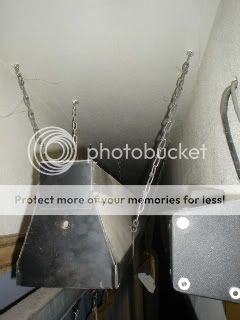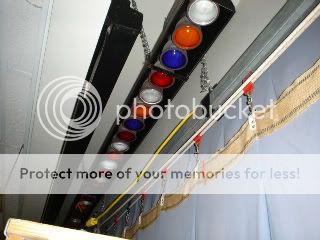As Mike Nicolai has so eloquently said, and provided specific source information to support his statements, as the rigging elephant in the
house (JR
Clancy) publishes,
trim chain for battens
and chain as a trim device on scenic units hung from battens does not fall into the
OSHA, or BOCA or other regulatory agencies definition of "
Overhead Lifting". In fact grade 30
Proof coil chain has a higher load
rating than the
lift line from which it is attached. 1/4"
GAC, the heaviest commonly used rigging cable has a WWL of 875#, Grade 30,
proof coil chain has a WWL of 1250# using the smallest load limit published by various manufacturers. As the standard use of
trim chain is with 1-1/2 wraps around the
batten and shackled back to the eye, the chain is actually only experiencing 1/2 the load. Which item is the weaker link? Grade 80 chain is inappropriate as
stage rigging chain as it does not suit the purpose and cannot be used with the appropriate connecting components if adjustibility of height is a desired factor.
As for hanging scenic units from a
batten, if you are hanging an object from a single
point, and it is to be subjected to oscillating and side loading, or if the chain is to be reeved over a gear wheel used as a drive mechanism, then you meet the definition of "
Overhead Lifting" and grade 30,
Proof coil chain is not appropriate. If you are hanging from two or more points, it is not
overhead lifting.
If chain is being used in a situation where greater strength is needed, there are two very good products,
Clancy Alpha chain and SECOA STC chain. They are both a grade 63 chain manufactured so that standard rigging components such as shackles, J&J turn buckles
etc. will fit in middle links as well as end links. Both have manufacturers ID stamped on every link and a date code on every 10th link so that lot and date of manufacture are traceable. Both cost several times the cost of Grade 30, 1/4" chain.
a standard rigging package for
theatre always includes a turn buckle so trimming at the pipe is hardly ever done.
Actually this is not true. First there is no "Standard rigging package". All the rigging manufacturers,
Clancy, Thern, H&H, Vortek, SECOA,
ETC et. al. offer several
batten attachment methods, turnbuckles are only about 1/3 of the available choices.
ETC Prodigy rigging does not offer turnbuckles at all.
Stage Electric battens, if hung from the brackets supplied by the
raceway manufacturer, are usually hing with turnbuckles, this is an excellent use of the device.
If "trimming at the pipe is hardly ever done" means turnbuckles at the
arbor, turnbuckles at the top of the
arbor instead of at the
batten is a poor choice of rigging practice. This places far too much hardware into a cramped, often inaccessible location. Properly mousing the turn buckles is a major PITA. In addition, the
trim device is in a remote location from the device being trimmed, thus one person cannot
trim the
batten without at least one additional
stagehand. If the
batten trim mechanism is at the
batten, a single
stage hand can properly and accurately
trim a
batten in a few minutes.




